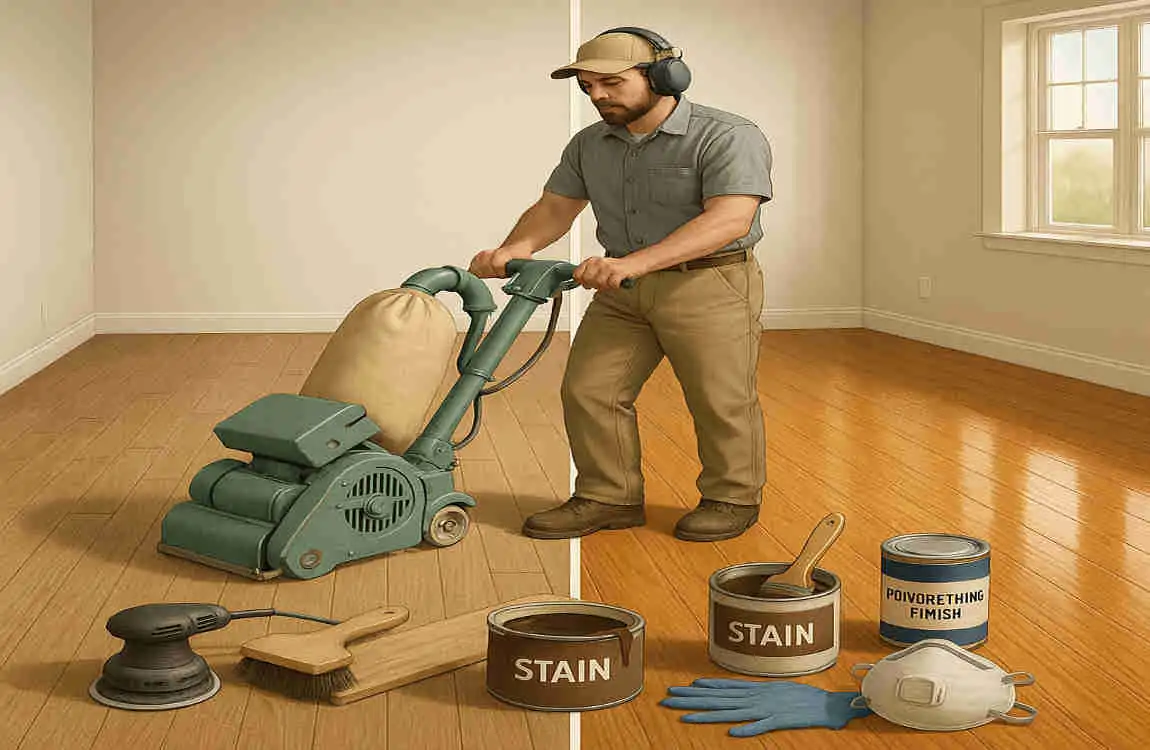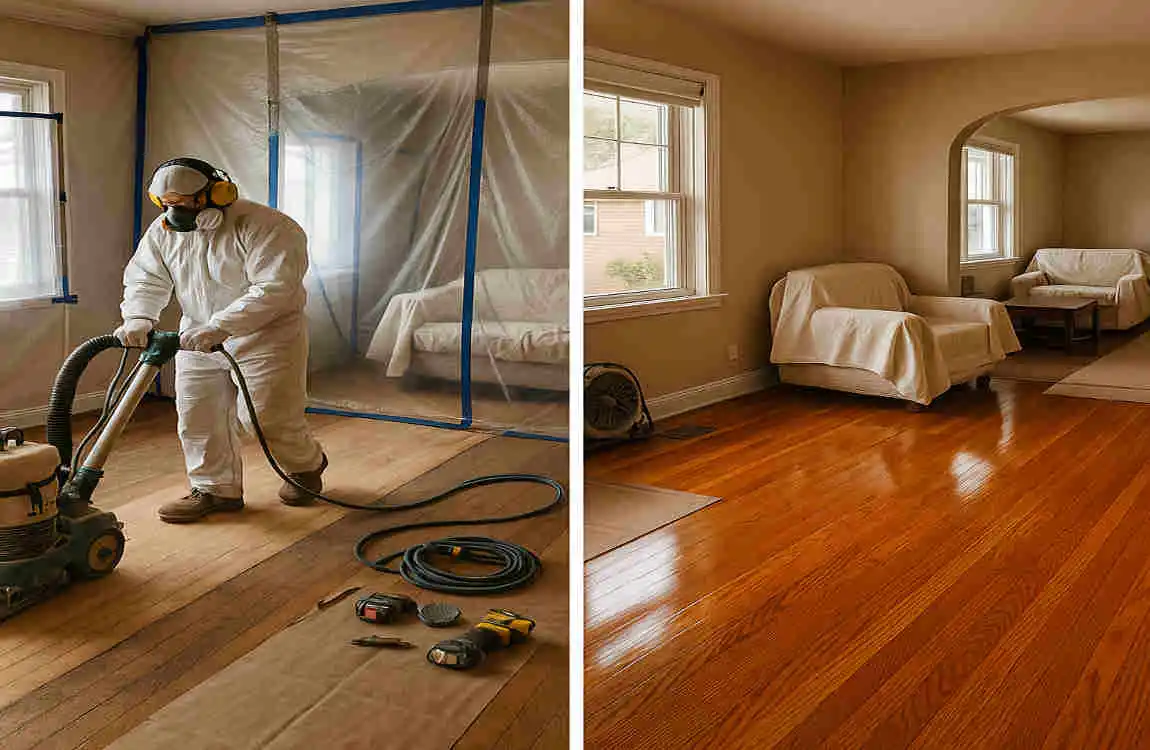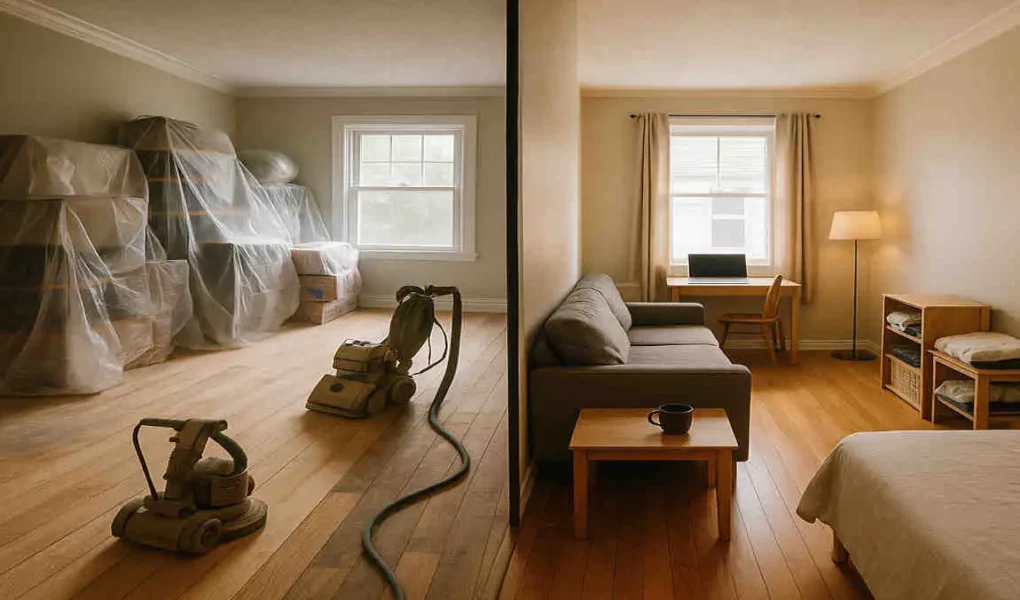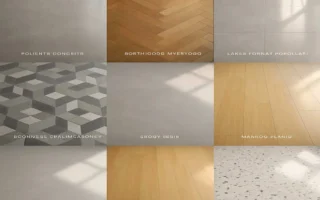Are you dreaming of revitalizing your home with beautifully refinished floors? Floor refinishing can breathe new life into your space, enhancing both its aesthetic appeal and value. However, if you’re living in the house during the process, it can feel like a daunting task. But don’t worry! With careful planning and the right strategies, you can successfully manage living in your home while refinishing your modern house floors.
Understanding Floor Refinishing

What is Floor Refinishing?
Floor refinishing is the process of restoring and enhancing the appearance of your floors. It typically involves sanding down the existing finish, repairing any damage, and applying new stains and sealants. This process can transform worn-out floors into stunning features of your home.
Typical Process and Timeline
The floor refinishing process generally includes several key steps:
- Preparation: Clearing the room, covering fixtures, and protecting adjacent areas.
- Sanding: Removing the old finish and smoothing the surface to achieve a smooth finish.
- Repairs: Filling in gaps, fixing scratches, and addressing any other damage.
- Staining: Applying the desired color to the wood.
- Sealing: Protecting the new finish with a sealant.
The entire process can take anywhere from a few days to a couple of weeks, depending on the size of the area and the extent of the work needed.
Types of Floors Commonly Refinished
While hardwood floors are the most common type to be refinished, other types, such as laminate and engineered wood, can also be revitalized. Each type may require slightly different techniques and products, so it’s essential to identify your floor type before beginning the project.
Challenges of Refinishing Floors While Living in the House
Dust and Debris Concerns
One of the biggest challenges of refinishing floors while living in your own house is managing the dust and debris generated during the sanding process. This fine dust can spread throughout your home, settling on surfaces and potentially causing respiratory issues.
Odors and Fumes from Finishes and Stains
The chemicals used in stains and finishes can produce strong odors and fumes. These can be particularly problematic in an occupied home, potentially causing discomfort or health issues for residents.
Noise Disruption from Sanding and Equipment
The sanding process can be noisy, which can disrupt your daily life, primarily if you work from home or have young children at home.
Limited Living Space During the Process
With furniture moved and rooms potentially off-limits during the refinishing process, you may find yourself with limited living space. This can be challenging, especially in smaller homes.
Planning Before Refinishing Floors
Assessing the Extent of Refinishing Needed
Before diving into the project, take the time to assess the extent of refinishing needed. Are you looking to refresh the entire house, or just a few key rooms? This will help you plan your approach and timeline.
Scheduling for Minimal Disruption
Consider the best time of year for your project. Spring and fall are often ideal, as you can open windows for ventilation. Also, consider the best days and times to work, minimizing disruptions to your family’s routine.
Preparing Family Members and Pets
Communicate with your family about the upcoming project, setting expectations for noise, dust, and limited access to certain areas. If you have pets, create a plan to ensure their comfort and safety throughout the process.
Choosing the Right Contractor or DIY Approach
Decide whether you’ll hire a professional or tackle the project yourself. If hiring a contractor, look for someone experienced in working in occupied homes. If going the DIY route, ensure you have the necessary skills and equipment.
How to Prepare Your Home for Floor Refinishing

Clearing and Protecting Furniture and Valuables
Before the refinishing house flooring begins, you’ll need to clear the rooms of furniture and valuables. Move items to a safe, dust-free area or cover them securely if they must remain in the room.
Creating Safe Zones and Barriers to Contain Dust
Use plastic sheeting and tape to create barriers around the work area, helping to contain dust and debris. Consider setting up a “clean room” where family members can retreat during the day.
Ventilation Strategies to Reduce Fumes
Open windows and use fans to improve air circulation, helping to dissipate fumes from stains and finishes. If necessary, consider investing in an air purifier to further improve indoor air quality.
Importance of Moisture and Temperature Control
Maintain a consistent temperature and humidity level in your home during the refinishing process. This helps ensure proper drying and curing of the new finish.
Practical Tips on How to Refinish Floors While Living in Your House
Refinishing One Room at a Time vs. Whole-House Approach
Consider tackling one room at a time to minimize disruption. This allows you to maintain a livable space while working on other areas. However, a whole-house approach can be more efficient if you can temporarily relocate.
Using Temporary Flooring or Rugs for Walkways
Lay down temporary flooring or rugs to create walkways through the work area, protecting your new finish and keeping dust at bay.
Setting Up Temporary Living or Sleeping Areas
If necessary, set up temporary living or sleeping areas in unused rooms or even the garage. This can help you maintain a comfortable space during the project.
Managing Daily Routines Around Work Hours
Coordinate with your contractor or plan your DIY work around your family’s daily routine. Try to schedule noisy tasks during times when the house is empty or when family members are less likely to be disturbed.
Safety Tips During Floor Refinishing
Personal Protective Equipment (PPE)
When working with chemicals and dust, always wear appropriate PPE, including gloves, eye protection, and a dust mask or respirator.
Handling Chemical Stains and Finishes Safely
Follow all manufacturer instructions for handling and applying stains and finishes. Work in a well-ventilated area and avoid skin contact with chemicals.
Protecting Children and Pets During the Project
Keep children and pets away from the work area during the refinishing process. If necessary, arrange for them to stay with family or friends during the most intensive parts of the project.
Cleaning and Maintenance During and After Refinishing
Daily Cleaning Tips to Minimize Dust Spread
During the refinishing process, perform daily cleanings to minimize the spread of dust. Use damp cloths and HEPA-filter vacuums to capture dust without stirring it up.
Proper Disposal of Waste Materials
Dispose of waste materials, such as sanding dust and empty chemical containers, in accordance with local regulations and guidelines. This helps protect the environment and your family’s health.
Post-Refinishing Care for Longevity of Floors
Once your floors are complete, maintain their beauty with regular cleaning and proper care. Use floor-specific cleaners and avoid harsh chemicals or abrasive tools that could damage the finish.
Alternatives to Traditional Floor Refinishing for Occupied Homes
Screen and Recoat Method
For a less invasive option, consider the screen and recoat method. This involves lightly sanding (screening) the existing finish and applying a new topcoat, minimizing dust and disruption.
Area-Specific Spot Refinishing
If only certain areas of your floors need attention, consider spot refinishing. This targeted approach can be less disruptive and more cost-effective than a complete refinish.
Using Low-VOC or Water-Based Finishes
Opt for low-VOC or water-based finishes to reduce odors and fumes during the refinishing process. These eco-friendly options are safer for occupied homes.
Hiring Professionals vs. DIY: What’s Best for Living in the House?
Pros and Cons of Professional Contractors During Occupancy
Hiring professionals can save you time and ensure a high-quality finish. However, it may be more expensive, and you’ll need to coordinate with their schedule.
DIY Approaches and Necessary Precautions
A DIY approach can be more budget-friendly and allow you to work at your own pace. However, it requires more time and effort, and you’ll need to take extra precautions for safety and quality.
Cost and Time Considerations
Consider both the cost and time implications of each approach. Professionals may be more expensive but faster, while DIY can save money but take longer.




